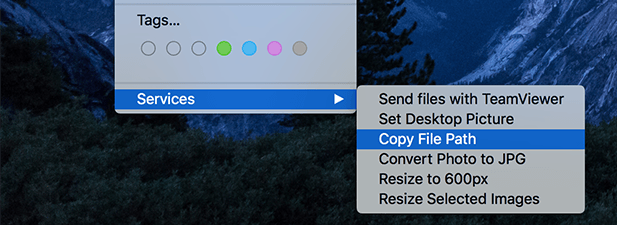
HOW TO FIND MAC OS PATH FULL
This will copy the full path of that file/folder on terminal as shown in the screenshot below.

To open press Command + Space, type terminal and hit enter.Ģ) Open Finder window and locate the file/folder for which you need the full path. By just dragging a folder into terminal we can get the full path on terminal.ġ) Open Terminal. To obtain a folders drive path for the myTechSupport form:1/ Click to select the folder2/ Hold 'command ' and press 'I' to open its 'Info' window3/ Triple. Method 3: Dragging the file or folder into the terminal To open this, right click on folder and click Get Info( or Press Command + i).You can select the path from this window and press control + c to copy the path. The info window of file/ folder shows you plenty of information about it, such as file size, file name etc. You can now paste the full path anywhere you like. Hold the option key then the options will change and you would be able to see the option: Copy “folder_name” as Pathname, click on it, the full path of the file/folder would be copied to the clipboard. Right click (control + click or two finger click on trackpad) on a Folder a context menu with options will popup. Method 1: Copy full path from Context menu Users/user/.In this guide, I will show you few easy ways to find and copy the full path of a file or folder in Mac. Restart the terminal and test if this has worked by entering this in the terminal. export PATH="/Users/user/.composer/vendor/bin:$PATH"Īs you can see it’s going to the bin directory, not to the actual composer file. The best generic way to find this out is to run /usr/libexec/javahome This is the natively supported way to find out both the path to the default Java installation as well as all alternative ones present. So an example would be something like for composer. 5 Answers Sorted by: 736 The location has changed from Java 6 (provided by Apple) to Java 7 and onwards (provided by Oracle). If you have the file available on your Mac, simply drag and drop it onto your Finder window, and the full file path will be displayed. You want to make sure that you enter the parent folder not the direct command as it will not work. Find the file path of the file you’re searching for, then select its file path Right-click the selected text and choose copy or use the control + c keyboard command There’s a simpler way, though. bash_profile file you want to type something like this it will be different depending on what you want to do. touch ~/.bash_profile nano ~/.bash_profile so open up a terminal and type the following. Meanwhile, Linux and Mac operating systems use the slash / to separate paths.


HOW TO FIND MAC OS PATH WINDOWS
A Windows based operating system uses the backslash to separate paths. A path separator separates the directories from one another and allows us to identify the path of a file. Adding the app path to the PATH variable.Īll we need to do is create a new hidden file called. A key difference is the path separator the operating systems use. After you’ve retrieved the desktop picture (use Command+Shift+G to bring up the Go To Folder window), or done what you have needed to do, you can hide the path text by using the following command: defaults delete desktop-picture-show-debug-text killall Dock.

sbin/ifconfig - with no PATH variable assigned. Go to the desktop to see the path printed over the wallpaper images. So you don’t have to remember the full path to the app to use it. Almost all Mac Applications use a standard dialog-box, which CAN allow you to specify the save-location easily. PATH variables allow certain apps to be accessed globally. To specify where to save, just as iSystem suggests, you would generally omit the actual filename, which leaves the pathname of a DIRECTORY, where your file (any name) can be saved. PATH variables are useful for some namely CLI (command line interface) apps.


 0 kommentar(er)
0 kommentar(er)
